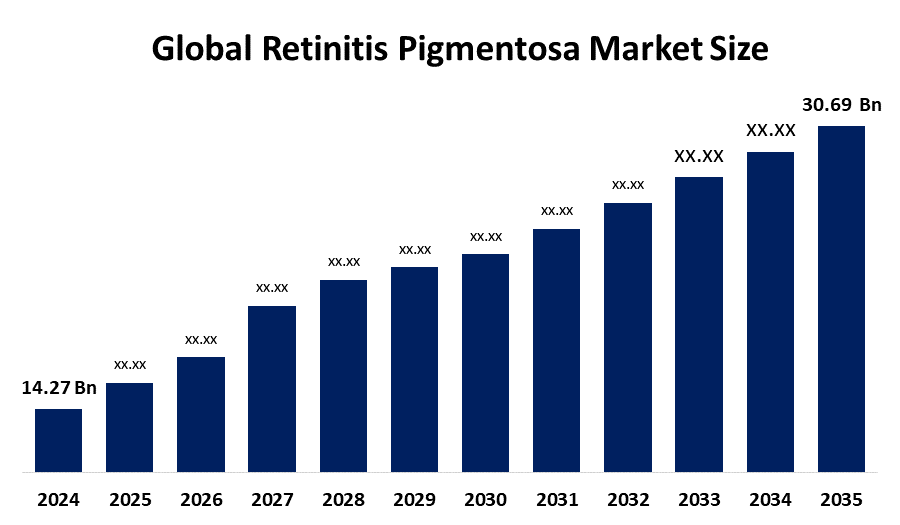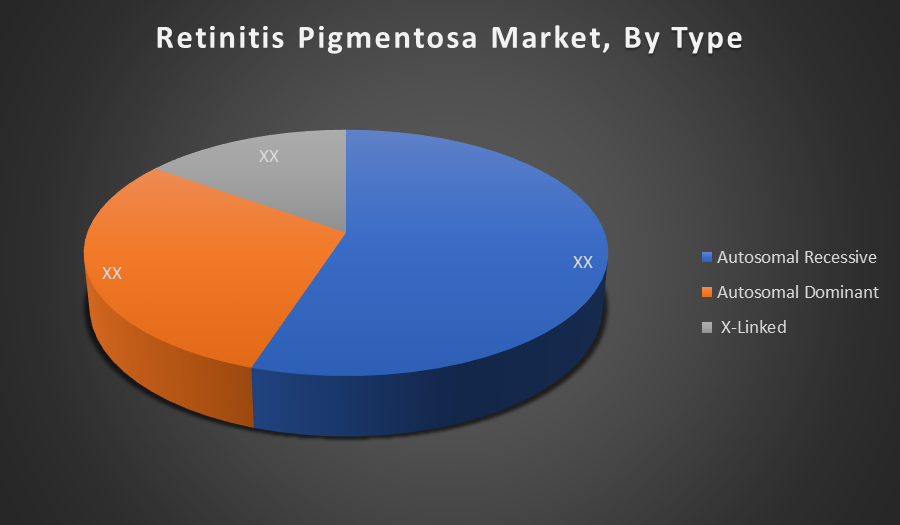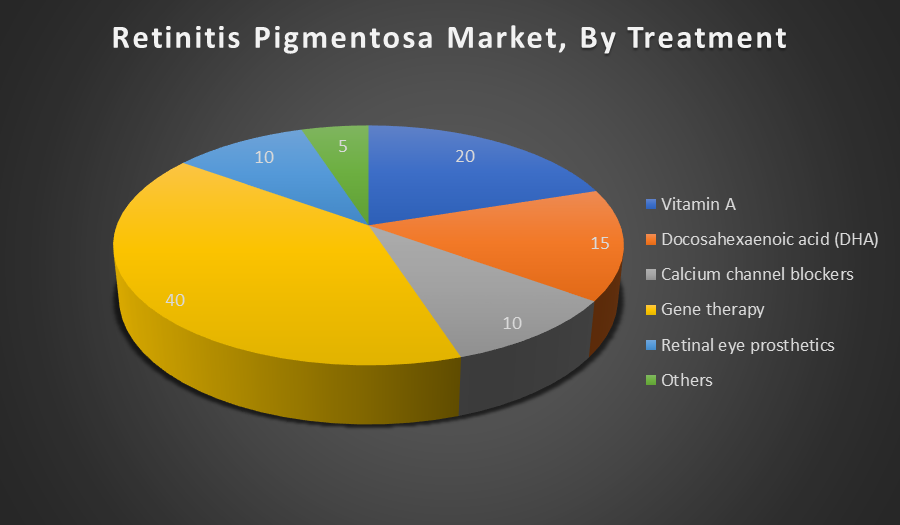- As per Spherical Insights & Consulting, The Global Retinitis Pigmentosa Market Size is expected to grow from USD 14.27 Billion in 2024 to USD 30.69 Billion by 2035, at a CAGR of 7.21% during the forecast period 2025-2035, owing to the launch of new therapies in the market and the rise in the number of cases.
- The leading Retinitis Pigmentosa Market Companies such as Bausch Health Companies, Novartis AG, Ocugen, Inc., Allergan (AbbVie), Astellas Pharma, AstraZeneca, Johnson & Johnson, Orphagen Pharma, Clino Corp, Spark Therapeutics, Caladrius Biosciences, Genethon, Gensight Biologics, MeiraGTx, and Others.

Retinitis Pigmentosa Treatment Market: Understanding and Treatment Algorithm:
Retinitis Pigmentosa (RP) is a group of rare, inherited eye disorders that cause progressive degeneration of the retina, leading to vision loss. It typically starts with night blindness, followed by loss of peripheral vision, and can eventually result in complete blindness. RP is caused by genetic mutations affecting photoreceptor cells.
Retinitis Pigmentosa Diagnosis:
Diagnosis of Retinitis Pigmentosa involves a combination of clinical evaluation and specialized tests. These include visual field testing, electroretinography (ERG) to measure retinal function, optical coherence tomography (OCT) to assess retinal structure, and genetic testing to identify mutations. Early diagnosis enables the management of symptoms and exploration of treatment or clinical trial options.
Retinitis Pigmentosa Treatment
There is no cure for Retinitis Pigmentosa, but treatments aim to slow progression and manage symptoms. Options include vitamin A supplements, retinal implants, gene therapy, and clinical trials exploring stem cell therapy. Wearing sunglasses and using low-vision aids can also help patients maintain their independence and improve the quality of their lives.
Retinitis Pigmentosa Epidemiology
The disease epidemiology covered in the report provides historical as well as forecasted epidemiology segmented by Total Diagnosed Incident Population of Retinitis Pigmentosa, Gender-specific Diagnosed Incidence of Retinitis Pigmentosa, Type-specific Diagnosed Incidence of Retinitis Pigmentosa, Age-specific Diagnosed Incidence of Retinitis Pigmentosa, Diagnosed Incident Population based on Primary Site of Retinitis Pigmentosa, and Diagnosed Incident Population based on Histologic Classification of Retinitis Pigmentosa Tumour in the global market covering North America, Europe, Asia-Pacific, Latin America, the Middle East, and Africa from 2024 to 2035.
Principal Insights
This section offers a global overview of retinitis pigmentosa epidemiology in major markets worldwide.
Country Wise- Retinitis Pigmentosa Multiforme Epidemiology
- The epidemiology segment provides Retinitis Pigmentosa prevalence data and findings across key regions worldwide, including North America, Europe (Germany, France, Italy, Spain, and the United Kingdom), Asia-Pacific (including Japan), Latin America, the Middle East, and Africa.
Retinitis Pigmentosa: Recent Developments:
- In August 2024, Ocugen announced FDA approval for its Expanded Access Program (EAP), allowing adults with early to advanced Retinitis Pigmentosa to receive the gene therapy OCU400 outside clinical trials. This supported patients with diverse RP gene mutations while the Phase 3 liMeliGhT study was ongoing, ahead of BLA submission.
Retinitis Pigmentosa Marketed Drugs:
- Luxturna: Spark Therapeutics (a Roche company)
Luxturna (voretigene neparvovec) is an FDA-approved gene therapy designed to treat patients with confirmed biallelic RPE65 mutation-associated retinal dystrophy, including Retinitis Pigmentosa. It delivers a functional copy of the RPE65 gene directly to retinal cells via an adeno-associated virus (AAV) vector, restoring vision and slowing disease progression.
- Syfovre: Apellis Pharmaceuticals
Syfovre (pegcetacoplan) is a complement C3 inhibitor approved for geographic atrophy secondary to age-related macular degeneration (AMD) and is under investigation for RP-related retinal degeneration. It works by blocking complement-mediated inflammation that contributes to retinal cell damage.
- N-Acetylcysteine (NAC): Johns Hopkins University (Investigational)
NAC is an antioxidant being tested in clinical trials for RP treatment. It helps reduce oxidative stress in retinal cells, potentially slowing photoreceptor degeneration and preserving vision.
Retinitis Pigmentosa: Emerging Therapies
- OCU400: It is a gene-agnostic modifier gene therapy designed to slow vision loss in patients with various genetic forms of Retinitis Pigmentosa. It works by modulating cellular pathways to protect photoreceptors and is currently in Phase 3 clinical trials.
- VG901: It is a gene therapy candidate targeting RPGR gene mutations responsible for X-linked Retinitis Pigmentosa. It uses an AAV vector to deliver a functional gene copy to retinal cells and is in early clinical development with an FDA rare pediatric disease designation.
- MCO-010: It is an optogenetic gene therapy for advanced RP that restores light sensitivity to retinal ganglion cells via expression of microbial opsins. It is in Phase 2/3 trials and has received Fast Track designation by the FDA.
- SPVN06: It is a mutation-independent gene therapy targeting cone photoreceptors to preserve and restore vision in RP patients. It’s currently in Phase 1/2 clinical studies focusing on safety and efficacy.
Retinitis Pigmentosa Market Outlook
- The Retinitis Pigmentosa market involves the development, production, and commercialization of treatments for Retinitis Pigmentosa—a group of inherited retinal disorders causing progressive vision loss. The market includes gene therapies, retinal implants, and pharmacological drugs aimed at slowing disease progression and improving patient quality of life.
- Key drivers of the market include increasing prevalence of inherited retinal disorders, advancements in gene and cell therapies, growing awareness of early diagnosis, rising investments in R&D, supportive regulatory approvals, and expanding healthcare infrastructure, all fueling demand for innovative and effective treatments worldwide.
- The Retinitis Pigmentosa market offers growth opportunities through advancements in gene and stem cell therapies, personalized medicine, and retinal implants. Increasing early diagnosis, strategic collaborations, and expanding healthcare access in emerging regions further drive innovation and improve treatment availability for patients globally.
- Government initiatives for Retinitis Pigmentosa focus on funding genetic research, promoting early diagnosis, improving accessibility for visually impaired individuals, and supporting clinical trials to accelerate the development of innovative therapies and enhance patient care worldwide.
- Challenges include high treatment costs, limited patient awareness, complex genetic variations, regulatory hurdles, and slow adoption of novel therapies in developing regions.
- The Retinitis Pigmentosa market is projected to grow steadily due to rising prevalence, advances in gene and cell therapies, increasing early diagnosis, and expanding healthcare infrastructure worldwide.
Retinitis Pigmentosa Market Segmentation
By Type:
- Autosomal Recessive
- Autosomal Dominant
- X-Linked

The Autosomal Recessive segment holds the largest share in the Retinitis Pigmentosa market due to its higher prevalence compared to other types. This inheritance pattern leads to more affected individuals, driving greater demand for diagnosis, treatment development, and targeted therapies in this segment.
By Treatment:
- Vitamin A
- Docosahexaenoic acid (DHA)
- Calcium channel blockers
- Gene therapy
- Retinal eye prosthetics
- Others

The Gene Therapy segment holds the largest share in the Retinitis Pigmentosa market due to its potential to address the root genetic causes of the disease, offering long-term vision improvement. Increasing FDA approvals and growing investment in gene-based treatments drive this segment’s dominance.
Regional Segment Analysis of the Retinitis Pigmentosa Market
North America holds the largest share of the Retinitis Pigmentosa market, driven primarily by the United States. This dominance is attributed to advanced healthcare infrastructure, high awareness levels, and significant investments in research and development. The region benefits from early adoption of innovative treatments such as gene therapies like Luxturna, supported by favourable regulatory frameworks, including fast-track approvals by the FDA. Additionally, extensive government and private funding for rare diseases enhances accessibility to cutting-edge therapies, contributing to the robust market size in North America.
The Asia-Pacific region is the fastest-growing market for Retinitis Pigmentosa due to improving healthcare infrastructure, rising patient awareness, and increasing government initiatives supporting rare disease treatment. Countries like China, India, and Japan are witnessing the rapid adoption of advanced diagnostics and novel therapies. Additionally, growing investments by global pharmaceutical companies in clinical trials and localized production are expanding treatment availability. Economic development and expanding healthcare coverage in emerging economies further fuel the region’s growth potential, making Asia-Pacific a key focus for future market expansion.
Retinitis Pigmentosa Market Key Companies
- Bausch Health Companies
- Novartis AG
- Ocugen, Inc.
- Allergan (AbbVie)
- Astellas Pharma
- AstraZeneca
- Johnson & Johnson
- Orphagen Pharma
- Clino Corp
- Spark Therapeutics
- Caladrius Biosciences
- Genethon
- Gensight Biologics
- MeiraGTx
- Others
Retinitis Pigmentosa Therapeutics Market Report Scope
- The Retinitis Pigmentosa therapeutics market report provides a detailed overview, covering its causes, symptoms, disease progression, and existing treatment options.
- Detailed insights into Retinitis Pigmentosa’s epidemiology and therapeutic approaches are included.
- Additionally, a comprehensive review of existing and emerging Retinitis Pigmentosa therapies is provided, including an evaluation of new treatments expected to influence the current Retinitis Pigmentosa treatment market landscape.
- The report includes a detailed review of the Retinitis Pigmentosa therapeutics market, both historical and forecasted, highlighting the global drug reach.
- The Patient-Based Retinitis Pigmentosa Market Forecasting report offers valuable insights into trends shaping the global Retinitis Pigmentosa market, helping to develop effective business strategies.
Retinitis Pigmentosa Treatment Market Report Insights
- Forecasting Market Trends Based on Patient Data and Disease Rates
- Retinitis Pigmentosa Therapeutic Approaches in Retinitis Pigmentosa
- Review Of Drugs in Development for Retinitis Pigmentosa
- Market, Growth, and Trends in Retinitis Pigmentosa
- Market Opportunities in Retinitis Pigmentosa Treatment
- Effects Of Future Therapies on Retinitis Pigmentosa Treatment.
Retinitis Pigmentosa Treatment Market Report Key Strengths
- 15 Years Retinitis Pigmentosa Market Forecast
- Global Coverage
- Retinitis Pigmentosa Epidemiology Segmentation
- Key Cross Competition
Retinitis Pigmentosa Treatment Market Report Assessment
- Present Practices in the Retinitis Pigmentosa Treatment Market
- Review of Investigational Retinitis Pigmentosa Drugs
- Attractiveness of the Retinitis Pigmentosa Drug Market
- Retinitis Pigmentosa Market Drivers
- Retinitis Pigmentosa Market Barriers
- SWOT
- Attribute Analysis
Market Segment
This study forecasts revenue at the global, regional, and country levels from 2020 to 2035. Spherical Insights has segmented the retinitis pigmentosa market based on the below-mentioned segments:
Global Retinitis Pigmentosa Market, By Type
- Autosomal Recessive
- Autosomal Dominant
- X-Linked
Global Retinitis Pigmentosa Market, By Treatment
- Vitamin A
- Docosahexaenoic acid (DHA)
- Calcium channel blockers
- Gene therapy
- Retinal eye prosthetics
- Others
Global Retinitis Pigmentosa Market, By Regional Analysis
- North America
- Europe
- Germany
- UK
- France
- Italy
- Spain
- Russia
- Rest of Europe
- Asia Pacific
- China
- Japan
- India
- South Korea
- Australia
- Rest of Asia Pacific
- South America
- Brazil
- Argentina
- Rest of South America
- Middle East & Africa
- UAE
- Saudi Arabia
- Qatar
- South Africa
- Rest of the Middle East & Africa






